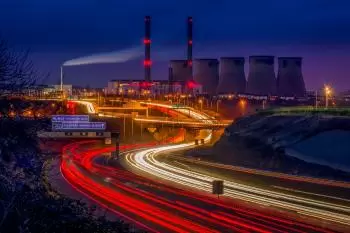
An electrical power plant is a facility to generate electricity. A power plant has equipment and devices to convert different kinds of energy into electrical energy. It also includes the structures and buildings necessary for this purpose.
The operation of the vast majority of power plants is based on the principle of converting the energy from various types of motors into mechanical energy of rotation of the rotor of an electric generator. Afterward, it is converted into electricity. There are also facilities for the direct conversion of energy into electrical energy, for example, photovoltaic plants that take advantage of solar energy.
Today, the most common type of power plant in the United States is the steam turbine power generating plant.
Thermal power stations
A thermal power plant is an electric power plant that creates electricity from thermal energy. The thermal source varies depending on the type of plant, but the principle of operation is the same.
The most widespread thermal power plants use the thermal energy released during the combustion of fossil fuels (coal, oil, gas, etc.). Thermal power plants produce more than 70% of the electricity on our planet.
It is due to the presence of fossil fuels in almost all regions of our planet. Another advantage is the possibility of transporting fossil fuels from the place of production to the power plant.
How does a thermal power plant work?
This type of power plant has an electric generator connected to a steam turbine. Water is heated to convert it into steam through the heat source. The steam generated drives a high-pressure steam turbine.
A significant part of the heat generated in thermal power stations is not used entirety. The waste heat is often discharged into the surface waters of a nearby river by cooling water with large cooling towers.
The most common thermal stations are steam turbines, gas turbines, internal combustion engines.
Types of thermal power plants
The different types of thermal power plants are classified depending on their heat source:
-
'Classic' thermal power plants
-
Coal-fired power plants
-
Gas power plants (natural gas)
-
Oil plants (fuel oil)
-
-
Nuclear power plants (nuclear fission)
-
Combined cycle plants
-
Biomass power plants
-
Waste incineration plants
-
Geothermal power plants (geothermal energy)
What is a combined heat and power plant?
Some of these power plants have the secondary function of generating heat for district heating or industry.
This type is called a combined heat and power plant. Such a power plant tends to be less efficient in generating electricity because some of the energy is deliberately used to create heat.
However, the total thermal efficiency is much higher because the released heat is used efficiently.
Sometimes, industries use this heat to drive steam turbines for technological needs.
Nuclear power plants
Nuclear power plants are a type of thermal power plant that uses thermal energy obtained from nuclear energy. Nuclear reactors get heat by provoking a fission chain reaction of nuclear fuel. The fuel used in these types of plants is usually uranium and plutonium.
The further conversion of thermal energy released in a nuclear reactor occurs similarly to a steam turbine power plant. The main advantage is the impressive amount of energy that each nuclear fission releases.
Nuclear power stations generate nuclear waste, which is very difficult to manage. They can also cause significant damage to the environment caused by accidents or abnormal situations during the operation of nuclear power plants.
On the other hand, this form of generating electricity emits neither air pollution nor greenhouse gases, so it does not contribute negatively to climate change.
Hydropower plants
Hydropower plants work by generating energy thanks to water stored at a certain height. Emblasted water has potential energy that, when dropped, is converted into kinetic energy. As the waterfalls, it drives hydraulic turbines that generate hydroelectric power (electricity).
Energy conversion in hydroelectric plants has the advantage of energy-carrying material: water is not destroyed like organic fuel but is conserved. Hydroelectric plants require significant capital investments for hydraulic structures (high dams, etc.) but low operating costs. Electricity generated in hydroelectric plants is the cheapest.
Pumped-Storage Hydropower
Some of these plants have a system to store potential energy when there is an electrical surplus.
These plants have reservoirs located at different heights. When electricity needs to be produced, water is released from the upper reservoir to power the turbines and is stored in the lower reservoir. If the electrical grid is generating excess electricity, water is pumped into the upper reservoir again.
What other power plants use renewable energy?
In addition to the power plants mentioned above and generally referred to as "traditional,” many power plants use renewable energy sources to generate electricity.
For example,
-
Photovoltaic solar power plants that work with photovoltaic panels capable of generating an electric current.
-
Wind power plants use wind currents to drive wind turbines as electrical generators.
-
Tidal power plants use the ebb and flow of ocean water.
-
Geothermal plants produce electricity using thermal energy from underground hot springs (geothermal energy).
-
Plants that use the temperature difference of water on the surface and in the ocean’s depths and others.
Electricity management
Power plants are combined into an energy system that also includes:
-
Installations that consume electricity
-
Power lines connecting them to power plants
-
Electronic devices with voltage rise and fall current transformers.
Long-distance electricity transmission over distances of up to thousands of kilometers is carried out through high-voltage power transmission lines 100 ... 750 kV, short-distance transmission - through voltage power transmission lines plus low up to 100 kV.